Last analysis warned it was possible that lows may again be tested, which is what has happened today. The Elliott wave target at 1,295 was inadequate; the low for the day was at 1,288.56.
Summary: The target is now 1,418. Strong bullish divergence between price and Stochastics suggests a low is in place now. Strong volume today may be a selling climax, typical of commodities.
Confidence now that a low is in place would come with a new high above 1,325.56.
Always trade with stops to protect your account. Risk only 1-5% of equity on any one trade.
New updates to this analysis are in bold.
Grand SuperCycle analysis is here.
Last in-depth historic analysis with monthly and several weekly charts is here, video is here.
There are multiple wave counts at this time at the weekly and monthly chart levels. In order to make this analysis manageable and accessible only two will be published on a daily basis, one bullish and one bearish. This does not mean the other possibilities may not be correct, only that publication of them all each day is too much to digest. At this stage, they do not diverge from the two possibilities below.
BULLISH ELLIOTT WAVE COUNT
FIRST WEEKLY CHART
Cycle wave b may be a single zigzag. Zigzags subdivide 5-3-5. Primary wave C must subdivide as a five wave structure and may be either an impulse or an ending diagonal. Overlapping at this stage indicates an ending diagonal.
Within an ending diagonal, all sub-waves must subdivide as zigzags. Intermediate wave (4) must overlap into intermediate wave (1) price territory. This diagonal is expanding: intermediate wave (3) is longer than intermediate wave (1) and intermediate wave (4) is longer than intermediate wave (2). Intermediate wave (5) must be longer than intermediate wave (3), so it must end above 1,398.41 where it would reach equality in length with intermediate wave (3).
Within the final zigzag of intermediate wave (5), minor wave B may not move beyond the start of minor wave A below 1,236.54. However, if it were now to turn out to be relatively deep, it should not get too close to this invalidation point as the lower (2)-(4) trend line should provide strong support. Diagonals normally adhere very well to their trend lines.
Within the diagonal of primary wave C, each sub-wave is extending in price and so may also do so in time. Within each zigzag, minor wave B may exhibit alternation in structure and may show an increased duration.
Within intermediate wave (1), minor wave B was a triangle lasting 11 days. Within intermediate wave (3), minor wave B was a regular flat lasting 60 days. Intermediate wave (5) is expected to be longer in price than intermediate wave (3), and it may also be longer in duration, and so minor wave B within it may also be longer in duration. If minor wave B is over at today’s low, it would have lasted 78 days.
This first weekly chart sees the upwards wave labelled primary wave A as a five wave structure. It must be acknowledged that this upwards wave looks better as a three than it does as a five. The fifth weekly chart below will consider the possibility that it was a three.
FIRST DAILY CHART
Minor wave B may again today be a complete regular flat correction. Minute wave c has overshot the lower trend line. Although this is not the most common look for a regular flat, it does sometimes happen.
A new high now above 1,325.56 would provide confidence that a low is in place. At that stage, upwards movement could not be a correction within minuette wave (v) of minute wave c, so minuette wave (v) and minute wave c would have to be over. Before this price point is passed a breach of the upper edge of the green Elliott channel about minute wave c would add reasonable confidence that a low is in place.
The target for minor wave C is recalculated today using the most common Fibonacci ratio to minor wave A. This would see intermediate wave (5) reach beyond its minimum required length. All Elliott wave rules would be met.
HOURLY CHART
Minute wave c may now be a complete five wave impulse ending with a swift strong fifth wave. This is common behaviour for commodities.
Within minuette wave (v), the strongest downwards movement is the fifth wave of micro wave 5 to end subminuette wave iii. This is very typical of Gold.
This wave count now absolutely requires a breach of the green Elliott channel in the first instance for confidence that a low is in place.
BEARISH ELLIOTT WAVE COUNT
FIFTH WEEKLY CHART
There were five weekly charts published in the last historic analysis. This fifth weekly chart is the most immediately bearish wave count, so this is published as a bearish possibility.
This fifth weekly chart sees cycle wave b as a flat correction.
If cycle wave b is a flat correction, then within it primary wave B must retrace a minimum 0.9 length of primary wave A at 1,079.13 or below. The most common length of B waves within flats is from 1 to 1.38 times the length of the A wave. The target calculated would see primary wave B end within this range.
Primary wave B may be subdividing as a regular flat correction, and within it both intermediate waves (A) and (B) subdivide as three wave structures. Intermediate wave (B) fits as a triple zigzag.
I have only seen two triple zigzags before during my 10 years of daily Elliott wave analysis. If this wave count turns out to be correct, this would be the third. The rarity of this structure is identified on the chart.
FIFTH DAILY CHART
Minor wave 1 may have been a relatively brief impulse over at the low of the 8th of February.
Minor wave 2 was labelled as an incomplete combination in last analysis. The new low today invalidates that labelling.
Minor wave 2 may be continuing as a flat correction. Within the flat correction, minute wave c would be extremely likely to make at least a slight new high above 1,361.46 to avoid a truncation and a very rare running flat. Minor wave 2 may not move beyond the start of minor wave 1 above 1,365.68.
I have tried to see a valid wave count with minor wave 2 over at the last high on the 11th of April, but I have been unsuccessful. That does not mean that a valid wave count does not exist, only that if it does I cannot yet find it. If I can find it, I will publish it. The problem is the upwards wave here labelled minuette wave (b). This movement will only subdivide as a corrective structure, and it will not subdivide as a motive structure and meet all Elliott wave rules. That upwards wave cannot be labelled minute wave c of minor wave 2.
The conclusion for this wave count is that minor wave 2 would be incomplete.
TECHNICAL ANALYSIS
WEEKLY CHART
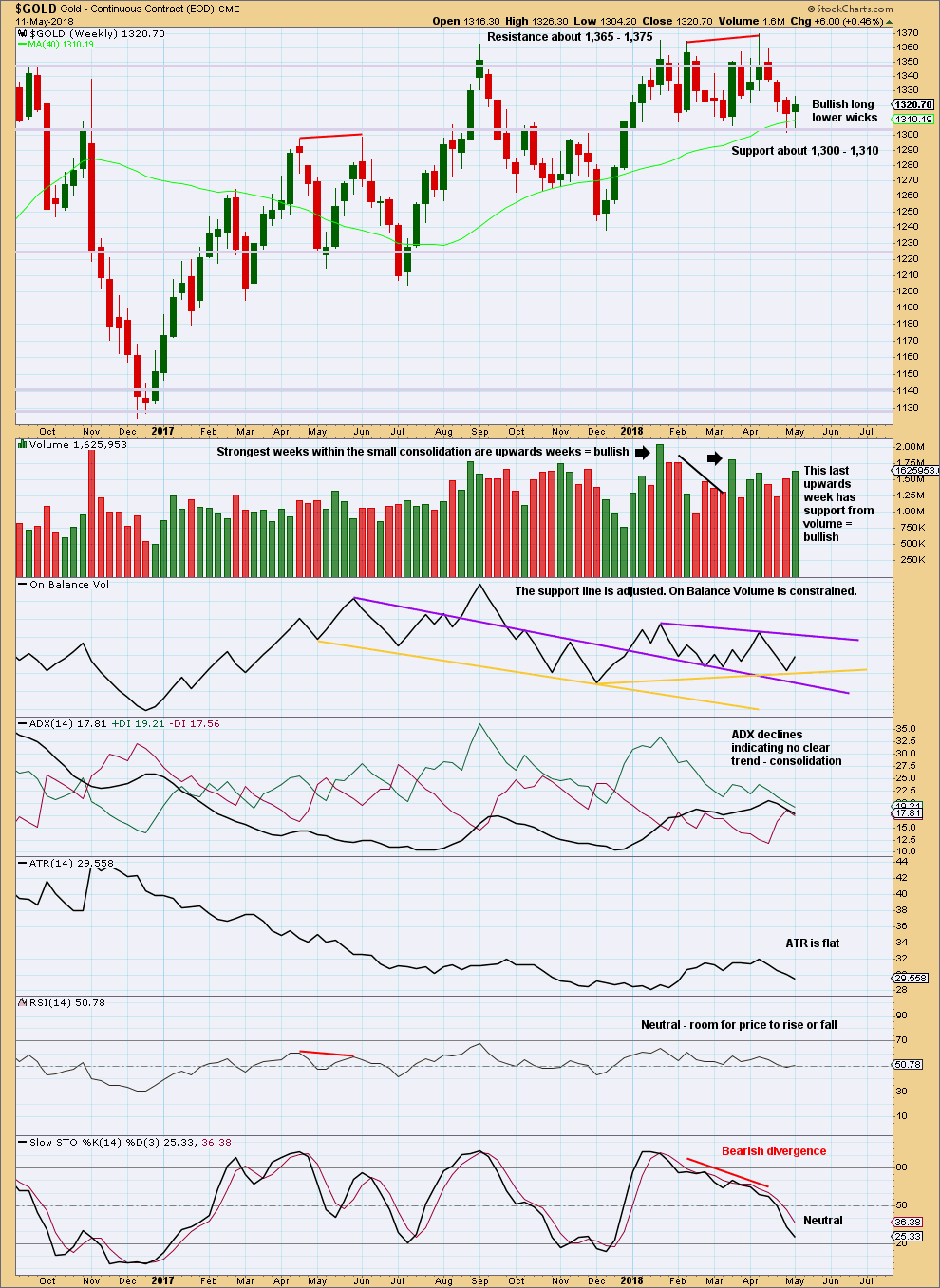
Click chart to enlarge. Chart courtesy of StockCharts.com.
Gold is within a small consolidation with resistance about 1,365 to (final) 1,375 and strong support about 1,310 to 1,305. Volume suggests an upwards breakout is more likely than downwards.
Last week’s candlestick has support from volume, which is bullish.
Gold looks reasonably bullish at the weekly chart level.
DAILY CHART
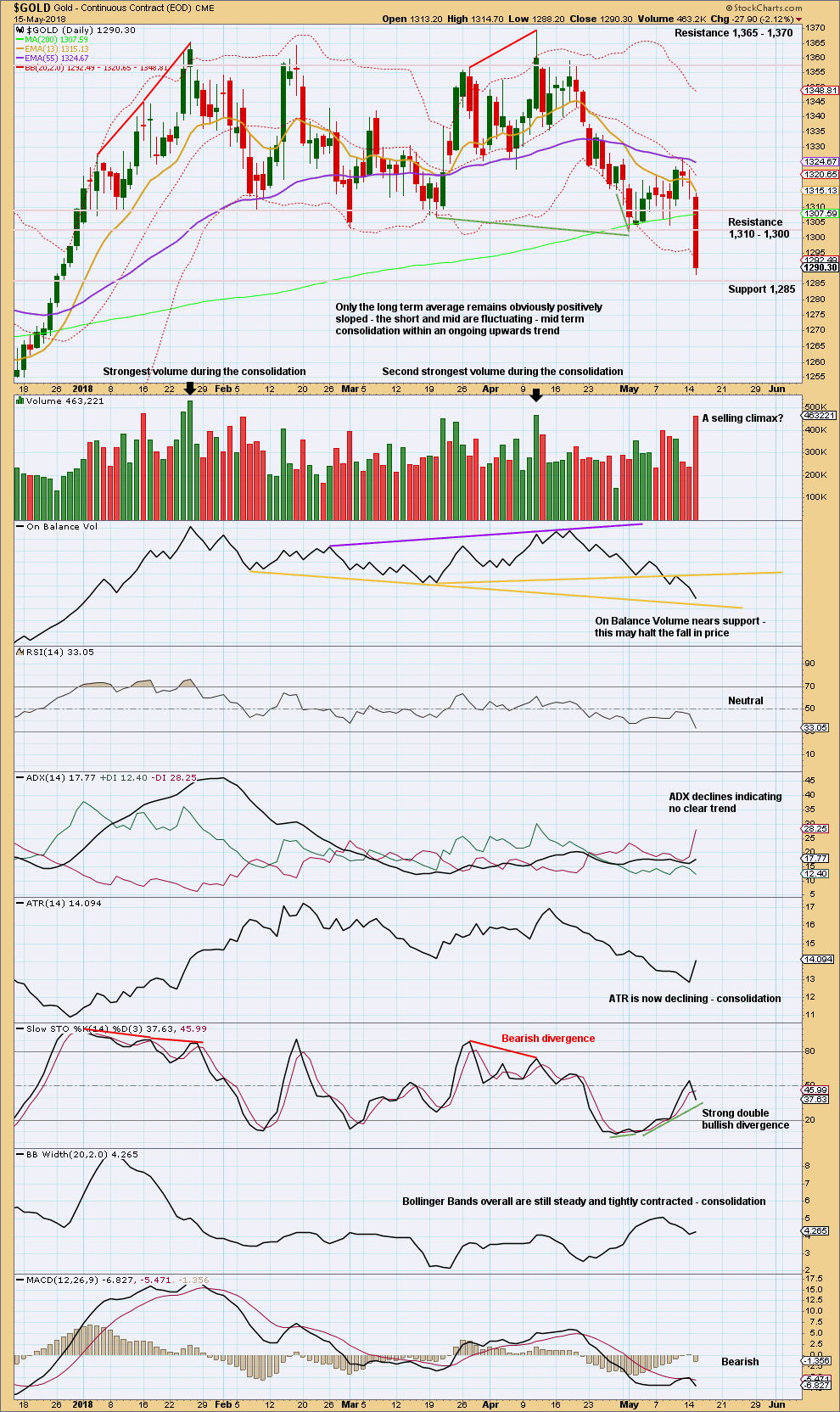
Click chart to enlarge. Chart courtesy of StockCharts.com.
Gold is within a consolidation that began back on about the 3rd of January. This consolidation is delineated by resistance about 1,360 to 1,365 and support about 1,310 to 1,300. It is still the upwards days of the 15th of January and the 11th of April that have strongest volume. This strongly suggests an upwards breakout may be more likely than downwards.
Support was delineated about 1,310 to 1,300, but price has closed below that today and is now close to next support about 1,285. Looks like today may be a classic downwards breakout from the consolidation zone, which has support from volume.
Today may also be a selling climax with an overshoot of support, and price may yet move back into the consolidation zone. Volume today is still lighter than the two prior strongest days, both of which were upwards days. There is some suggestion that this may be the case today due to very strong bullish divergence between price and Stochastics.
GDX WEEKLY CHART

Click chart to enlarge. Chart courtesy of StockCharts.com.
Support about 20.80 has been tested about eight times and so far has held. The more often a support area is tested and holds, the more technical significance it has.
In the first instance, expect this area to continue to provide support. Only a strong downwards day, closing below support and preferably with some increase in volume, would constitute a downwards breakout from the consolidation that GDX has been in for a year now.
Resistance is about 25.50. Only a strong upwards day, closing above resistance and with support from volume, would constitute an upwards breakout.
Overall, a slow upwards swing may be underway. Do not expect it to move in a straight line; it may have downwards weeks within it.
The short term volume profile remains bearish, but this week On Balance Volume gives a bullish signal.
GDX DAILY CHART
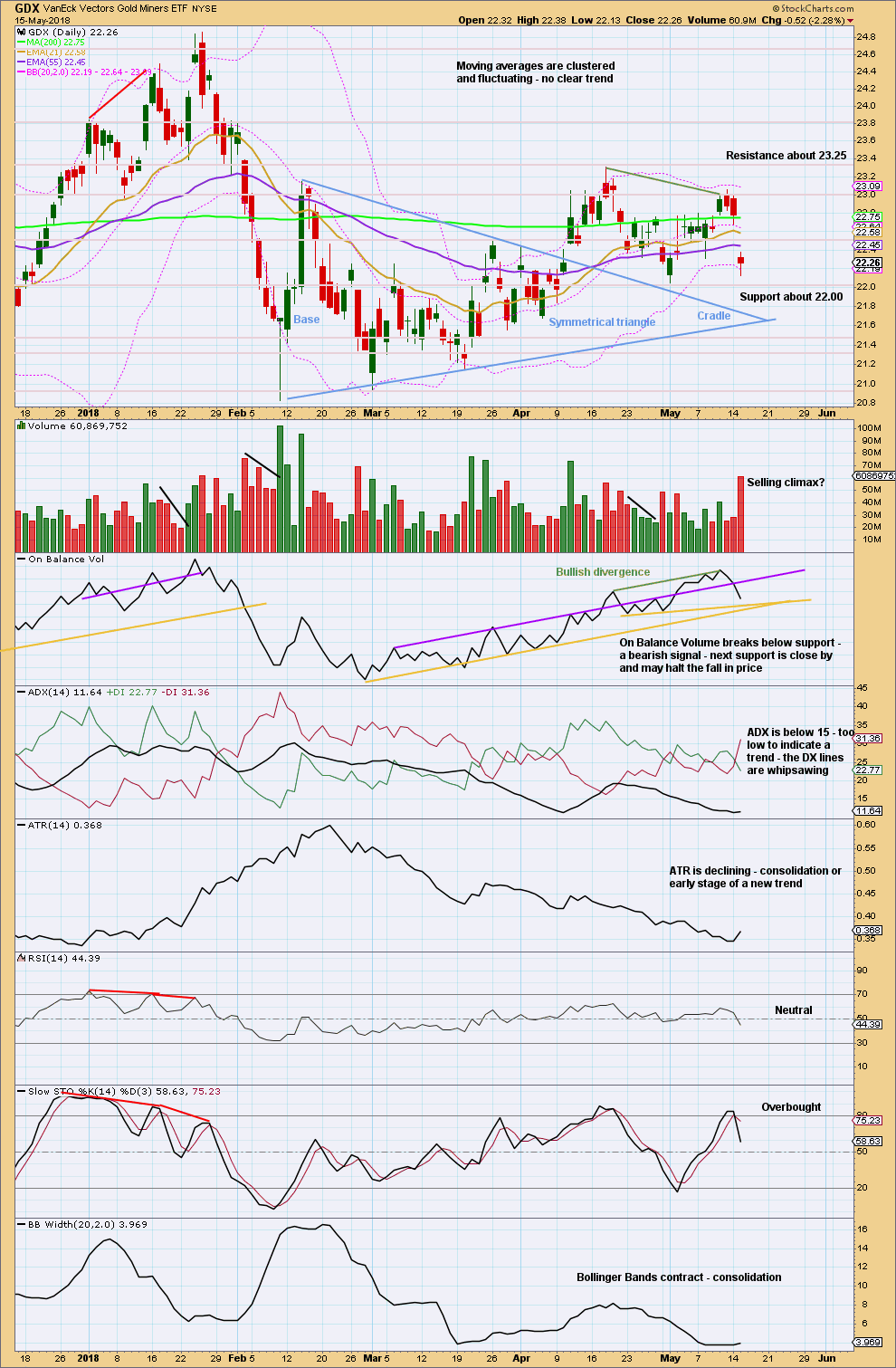
Click chart to enlarge. Chart courtesy of StockCharts.com.
On trading triangles from Dhalquist and Kirkpatrick, page 319:
“The ideal situation for trading triangles is a definite breakout, a high trading range within the triangle, an upward-sloping volume trend during the formation of the triangle, and especially a gap on the breakout. These patterns seem to work better with small-cap stocks in a rising market.
Although triangles are plentiful, their patterns suffer from many false and premature breakouts. This requires that a very strict breakout rule be used, either a wide filter or a number of closes outside the breakout zone. It also requires a close protective stop at the breakout level in case the breakout is false. Once these defensive levels have been exceeded, and price is on its way, the trader can relax for a little while because the failure rate after a legitimate breakout is relatively low. Trailing stops should then be placed at each preceding minor reversal.
…. in symmetrical triangles, the best performance comes from late breakouts in the 73% – 75% distance.
Volume on the breakout seems more desirable in symmetrical triangles.”
In this case, the breakout has come 61% of the triangle length from base to cradle. Volume towards the end of the triangle declined. The breakout is accompanied by a gap and has good support from volume.
Pullbacks occur 59% of the time for symmetrical triangles.
The pullback has continued lower. Next support is close by about 22.00 and thereafter at the apex of the triangle. Support for On Balance Volume is close by.
Bullish divergence between price and On Balance Volume at the last highs three days ago still remains valid, and it still supports the idea of new highs from price to follow through.
Published @ 10:48 p.m. EST.

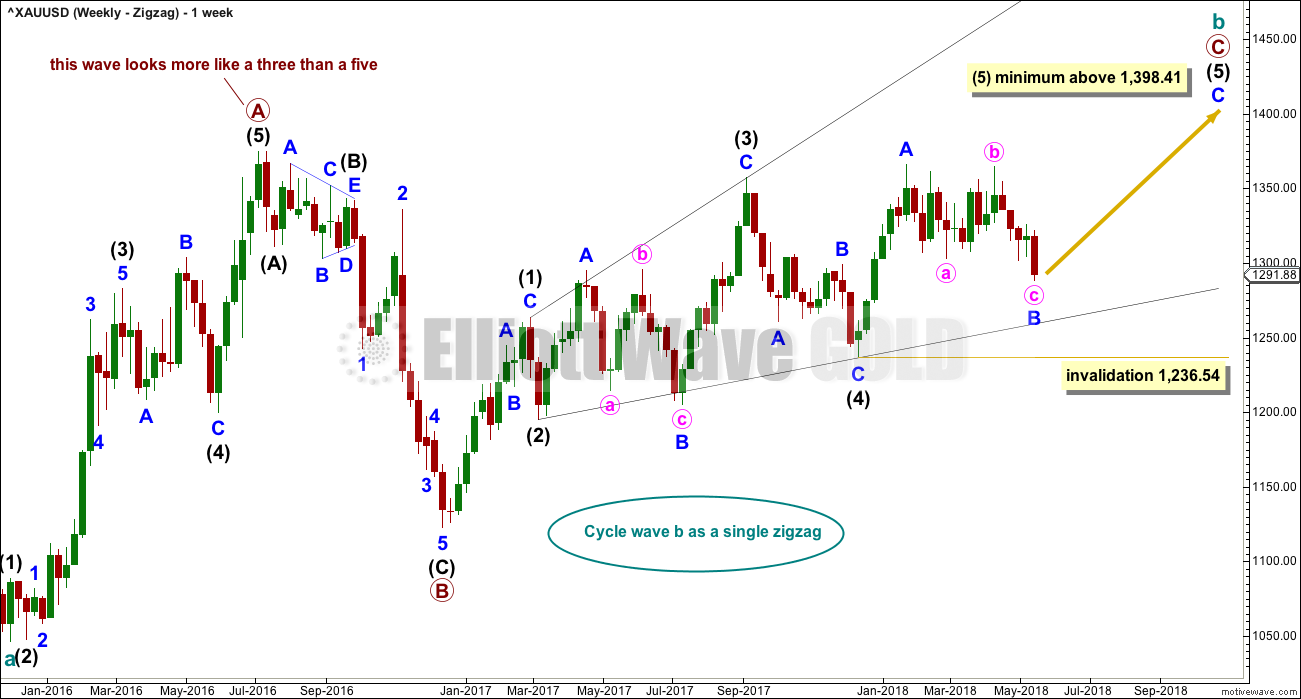
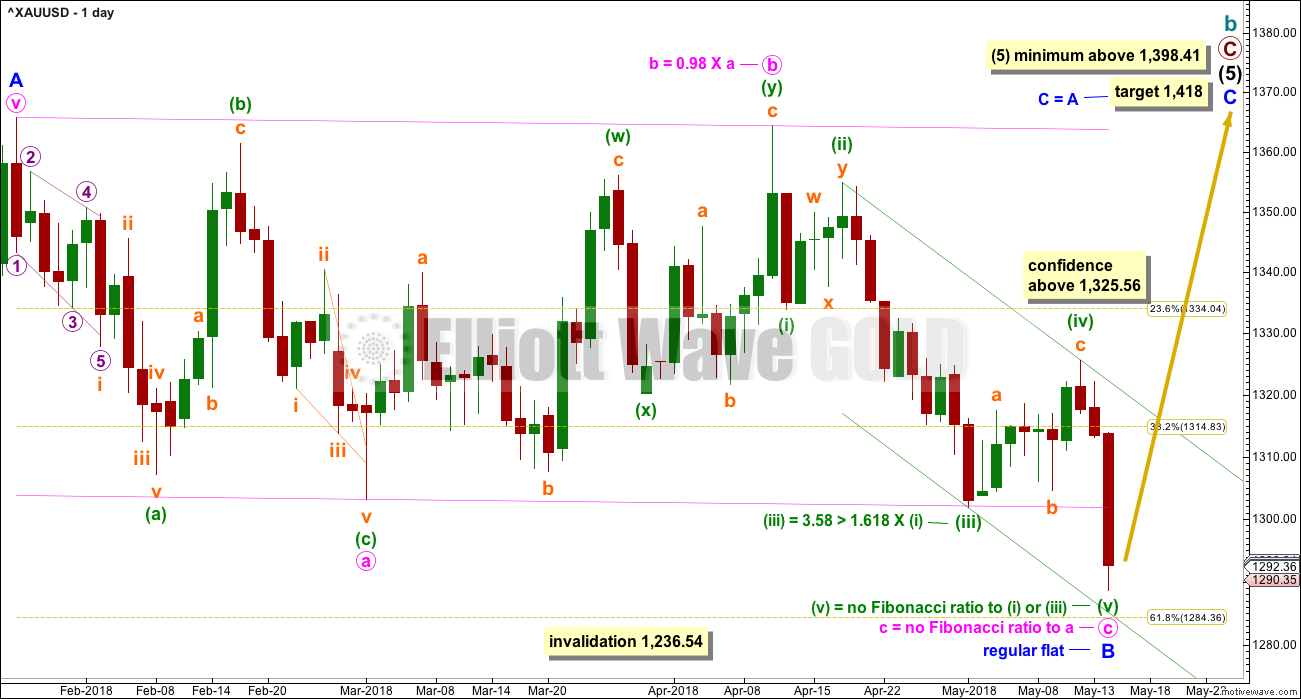
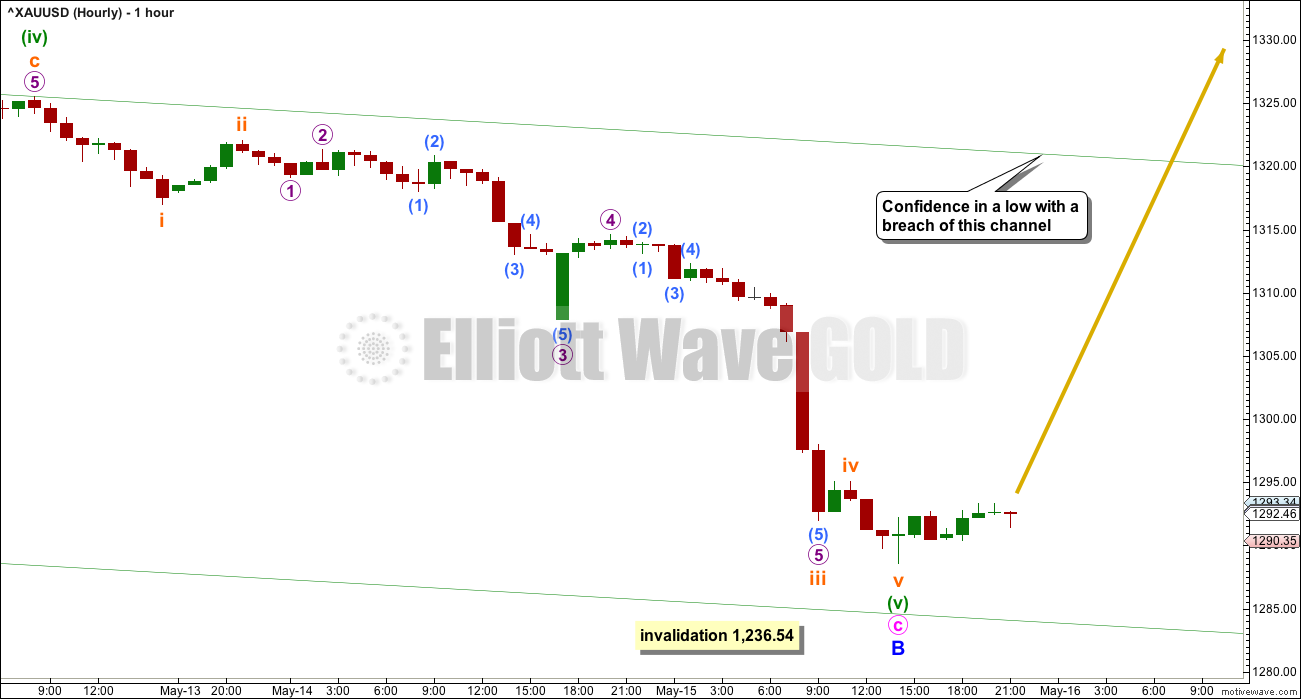
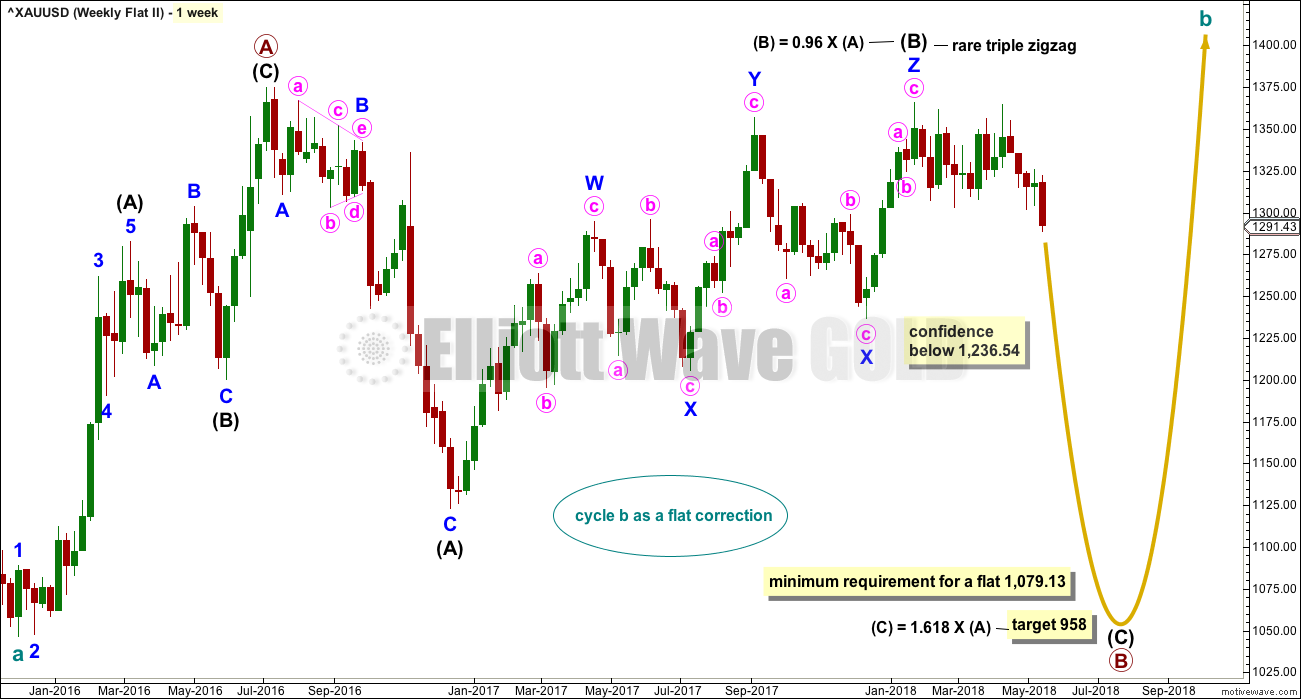
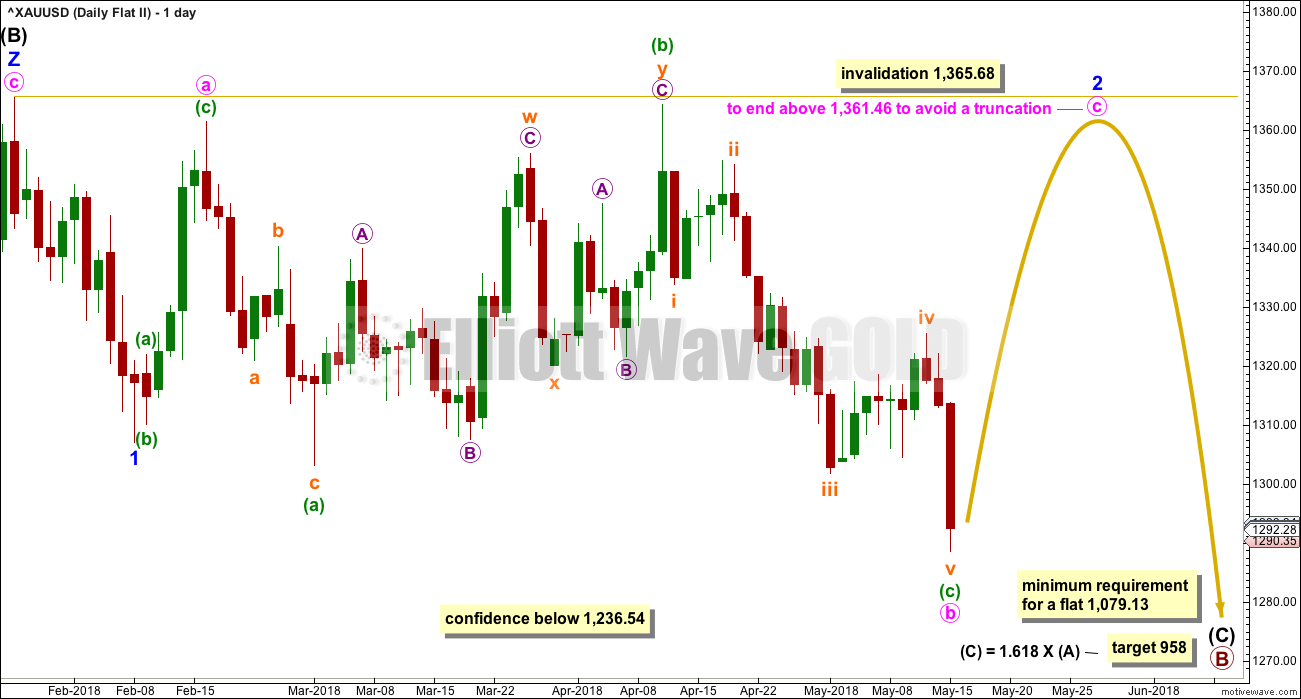
Lara, I think we may have one more leg down for Gold. Possibly as low as 1,273ish, where Minuette 5 = 1.618 x Minuette 1
I have an alternate which allows for one more low.
I’ll calculate the target at submineutte degree though, because there’s already a Fibonacci ratio between minuette waves (i) and (iii).
Updated hourly chart:
Another slight new low. Let’s see how much (if any) weakness today has.
I know this may be really testing the patience of many members here.
I still think this count is correct: call option premiums for NUGT expiring June 15th increased today, even though NUGT closed slightly down. Also silver closed up nicely, which leads me to believe gold will soon follow… I would definitely not be in the bull camp if GDX and silver were not in the green today.
Of course gold will have resistance in 1300-1310 region, but that’s expected. Minuette (ii) and/or minute ii corrections have to show up somewhere 🙂
There’s actually another variation that doesn’t bounce much. Price just moves down to make another lower low to complete Minor wave 2.
Hi Dreamer. For amongst the silent observers like me, its always beneficial to follow your charts and comments and Lara’s end of day synopsis. Really at this stage it is hard to tell which way Gold price will swing. Imo at current price levels (1290s) it looks unlikely Gold price will get past 1300-1306 before attempting a break below 1280. Lets see what happens in the coming days. This has been very testing (and foggy) times since the 1302-03 low in March! Does Gold price really have what it takes to head on up for 1400+ this year?
And here’s an idea for another small leg down.
Which one do you all like?
https://www.tradingview.com/x/BFGL42ir/
I like the look of this one for GDX better.
But then, it’s waves don’t always look great, the volume is too low.
Nice work Dreamer! Thank you for sharing
Both are valid Dreamer. Thanks for the chart work…
I vote for “the bottom is in” chart based on the action today.
While gold made a lower low overnight, GDX is up this morning… and also silver is behaving stronger than gold… unless gold breaks into the 1270’s, I don’t see GDX going below 22…
Is the bottom in? Both Gold and GDX have a little room before OBV finds support. The rebound so far has been anemic.
As far as GDX goes, there was a big gap down, then prices stabilized; yet price did not stage a strong rebound. GDX still has not corrected past the .618 retrace as I was looking for after a leading diagonal.
The next 2-3 days are key. I can see a completed Minor wave 2 -OR- I can see another small leg down for a deeper retrace.
Let’s see what happens
Here’s the count for “the Bottom is in”
https://www.tradingview.com/x/JGx7XYXl/